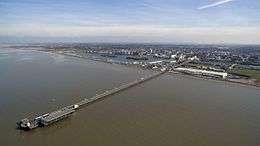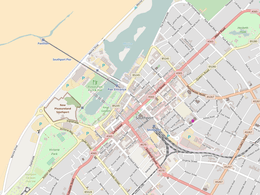Southport Pier
Coordinates: 53°39′11″N 3°01′01″W / 53.653°N 3.017°W
|
Southport Pier in 2016 | |
| Type | Pleasure |
|---|---|
| Carries | Pedestrians |
| Locale | Southport |
| Maintained by | Sefton Council |
| Design | James Brunlees[1] |
| Owner | Sefton Council |
| Total length | 1,108 metres (3,635 ft)[1] |
| Opening date | August 1860 |
|
Southport Pier location within Southport | |
Southport Pier is a Grade II listed pleasure pier located in Southport, Merseyside, England. First opened in August 1860, it is the oldest iron pier in the country and spans a length of 1,108 metres (3,635 ft), making it the second longest in Great Britain after Southend Pier. The local council seeked to have the pier demolished in 1990 due to rising costs, yet were defeated in their attempt by a single vote and subsequent restorations have been undertaken with the help of grants and lottery funding.
The Southport Pier Tramway ran from Southport Promenade to the pier head at various times in the pier's history, most recently from August 2005 until June 2015.[2]
Location
The entrance to the pier starts at Promenade road and follows a route inland next to Princes Park, before crossing over Marine Drive and meeting the beach at approximately half way along its length. At a total length of 1,108 metres (3,635 ft)[1], it is the second longest pier in Great Britain.[lower-alpha 1][3] A portion of the pier passes over land before reaching the beach, although this wasn't always the case, as silting near the beach over the course of time has allowed land to be reclaimed.[4] The pier is a 7 minute walk from Southport railway station, at a distance of 0.3 miles (0.48 km).[5]
History

The pier first opened in 1860, then-reaching out 3,600 feet (1,100 m), having been initially proposed during the 1840s.[1] The pier is the oldest iron pier and pleasure pier in the country.[4] Within its first few years of operation, waiting rooms for boat passengers had been added and a cable-operated tramway was installed by 1865. In 1868, it was extended to 4,380 feet (1,340 m), though storm damage and fires in 1933 and 1957 respectively has reduced its length to the present day 3,633 feet (1,107 m).[1]
_(LOC)_(15616162604).jpg)
It was listed at Grade II on 18 August 1975 despite being in a state of deterioration, which continued during the latter 20th century and worsened by a storm in 1989 which caused extensive damage. Despite its status as a listed building, Sefton Council seeked to demolish the pier in 1990 due to the rising cost of repairs and maintainance, yet was defeated by a single vote.[4] With estimates close to £1million to secure the future of the pier and a further £250,000 required every five years for repainting, a charitable trust was formed in 1993 to upkeep the pier, with various funding secured in the subsequent years to maintain the pier's operation.[1]
The pier today is a completely open structure, with modern railings on an older base, and a deck made of hardwood slats, affording a partial view of the sea below. The modern structure at the pier head, the Pavilion, was designed by Liverpool architects Shed KM. The building houses a cafeteria with airport style floor to ceiling windows overlooking the beach and a collection of vintage mechanical amusement machines, re-creating a traditional pier-end penny arcade.
The exhibition of Edwardian and Victorian machines operates on pre-decimalisation pennies, which are available to purchase on-site (£1 buys 10 old pennies) and has proved very popular with locals and tourists alike.
Tramway

The first tramway on Southport Pier was a line for carrying baggage that opened in 1863. The line was upgraded to cable operation in 1865 and re-laid in 1893, with electrification coming in April 1905. The rolling stock was rebuilt in 1936 when the line was taken over by Southport Corporation.[1] The pier was closed during the Second World War and when it reopened the tram did not reopen with it, as the town had lost its supply of DC electricity.[4] When it finally reopened in 1950, the line had moved to the side of the pier from its previous central position, the gauge had been changed from 3 ft 6 in (1,067 mm) narrow gauge to 1 ft 11 1⁄2 in (597 mm) narrow gauge, and the line was now diesel operated with two new trains, known as the Silver Belle, built by local engineer Harry Barlow, owner of the Lakeside Miniature Railway.[1]
In 1973 the train was replaced with English Rose, a new model built by Severn Lamb.[6][7] The Silver Belle stock was unused and increasingly derelict at Steamport for some years, then at the West Lancashire Light Railway.
The pier was closed for safety reasons in 1998, however the Southport Pier Trust had been formed in 1991 to campaign for the pier's restoration and, by 1999, Sefton Council and the Pier Trust had raised funds to commence the restoration of the pier. The first phase of this restoration was completed in 2002 and included providing a new 3 ft 6 in (1,067 mm) narrow gauge tram track in the centre of a widened deck.
On 1 August 2005, a new twin-section articulated, battery powered tram car started service on this track.[8][9] The tram car was manufactured by UK Loco Ltd. and offered a passenger capacity of 74 on the length of 24 yards (22 m) and the width of 7.9 feet (2.4 m).[10] The tram ran every day of the year except Christmas Day, and provided a half-hourly service in both directions. The operating hours varied depending on the time of year and the day of the week.[11]
In June 2015, the Southport Pier tram service stopped due to rising maintenance costs and council cost-cutting measures. It has been replaced by an extension of a preexisting smaller land train,[2] and the tram was removed from the pier in March 2016 in order to be sold.[12]
Improvements

Recent modernisation and repair of the pier formed part of a wider redevelopment strategy, including the new Marine Drive sea wall, landscaping around the pier and the new tram route and the new £23m Ocean Plaza shopping centre, which presents a blank back wall on the seaward side. Completion was in 2002.[13]
A grant of £62,400 (equivalent to £189,887 in 2015) was given in 1983 by the European Regional Development Fund to strengthen to pier's structure.[14]
In February 1997, a grant of £34,000 (equivalent to £55,804 in 2015) was given from lottery funding in order for a structual survey to be undertaken.[15] As of January 2002, the pier had received around £1.73M from the Heritage Lottery Fund, comprised from two separate awards.
Cultural references
The pier has been part of some films during the 1980s, most notably the 1985 film Mr. Love, which was filmed largely in Southport.
Awards
- 2003 National Piers Society Pier of the Year
See also
- Listed buildings in Southport
- Southport Corporation Tramways
- List of town tramway systems in England
- List of town tramway systems in the United Kingdom
References
Notes
- ↑ Southend Pier is the longest in the country, at a length of 2,158 metres (7,080 ft)
Citations
- 1 2 3 4 5 6 7 8 "Southport Pier Statistics". National Piers Society. Retrieved 14 April 2017.
- 1 2 "End of the line for iconic Pier Tram after rising maintenance costs". Champion. Retrieved 2015-06-06.
- ↑ "Southport Pier - The Piers". The Pier. Retrieved 12 May 2017.
- 1 2 3 4 "14 bizarre facts about Southport Pier only local people would know". Southport Visiter. 29 August 2016. Retrieved 10 August 2017.
- ↑ "Distance from Southport Railway Station to Southport Pier" (Map). Google Maps. Retrieved 11 August 2017.
- ↑ "History of Southport Pier". National Piers Society. Retrieved 2010-08-29.
- ↑ "Southport Pier". the-pier.co.uk. 31 August 2008. Retrieved 29 August 2010.
- ↑ "Southport Pier tram arrives". Light Rail Transit Association. 2005-08-06. Retrieved 2010-08-29.
- ↑ "Tourist and Enthusiast Railways - North West". Glyn Williams. Retrieved 2010-08-29.
- ↑ "Battery Electric Tram". uk192.com. Retrieved 11 July 2011.
- ↑ "Southport Pier". www.visitsouthport.com. Sefton Borough Council Tourism Department. Retrieved 29 August 2010.
- ↑ Lally, Kate (24 March 2016). "Southport Pier tram removed before being sold". Southport Visiter.
- ↑ CABE case study
- ↑ "Pier Restoration: EEC Aid, 1984". Millbank Systems. 31 July 1984. Retrieved 21 April 2017.
- ↑ "Seaside Piers - Improvement Grants". Millbank Systems. 2 June 1997. Retrieved 14 April 2017.
Further reading
- Easdown, Martin (2009). Lancashire's Seaside Piers. Barnsley: Wharncliffe Books. ISBN 978-1-84563-093-5.
External links
| Wikimedia Commons has media related to Southport Pier. |
- Southport Pier at visitsouthport.com
- History of Southport Pier
- Pictures of Southport Pier
- Southport Pier Railway c1991 from flickr
- Southport Pier Webcam

